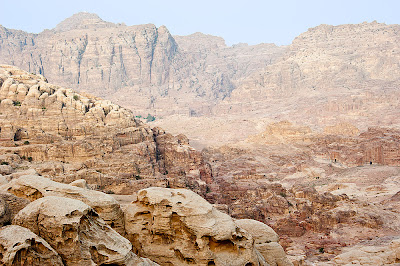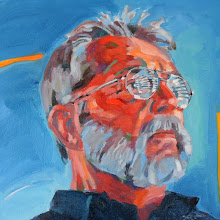Friday, April 19, 2013
Blue Mosque
Went over to the blue Mosque early to photograph the interior. The column to the right in this photo looking up at the dome is 15 feet or more thick to support the dome.
Jerash
 |
| Hadrian's Arch |
 |
| The Old and The New cities |
 |
| North Theater |
 |
| Columns at Temple of Artemis |
 |
| Colonnaded Cardo, The Main Street |
 |
| Grooves in Street from Roman Chariots |
Jerash is one of the best preserved Roman Cities in the Eastern Mediterranean. It was a large city with three theaters, the largest seating over three thousand, and a hippodrome where Roman chariots are still raced for the tourists. Jerash is set in the hills of Gilead and was founded in 170 BC and may have had a population of 25,000 in the second century.
Thursday, April 18, 2013
Madaba
 |
| Ropes from Street Banners |
 |
| Fruit Stand |
Back at our starting point of Madaba. There are many banners over the street and when they are cut down fences are poles are left with the rope remains.
Our favorite restaurant is in the center of town across from the St George Church. From our second story table we look out over the church and the town. Supposedly the best restaurant in town is a block down in an old stone building. When Bill Clinton was in town he ate there and we will try it on our last night in town.
Wednesday, April 17, 2013
Istanbul
 |
| The Blue Mosque |
 |
| The Aya Sofya |
Got into Istanbul at 6AM after taking the night plane out of Jordan. When I got to the hotel the light was so great for photography that I went right up to the rooftop restaurant of the Seven Hills Hotel. The restaurant wasn't open but they were kind enough to let me go up there. This open air restaurant on the seventh floor must have the best view in Istanbul. It has great views of both the Blue Mosque and the Aya Sofya to the NW and a panoramic view of the Sea of Marmara to south and east.
The structures you see to the lower right of the photo of the Aya Sofya are part of the excavation of the Byzantine Palace. Just a short block from the hotel you can go down some stairs behind a cafe and enter part of the palace that has been excavated.
The Tulips and other flowers are at their best now. They really do have a huge variety of Tulip colors and they seem to be growing everywhere.
There will be more of the Jordan blog in the next day or two. In some areas where we travel I will hold the blog entry so it is not posted while we are at that location or post where we are staying or going until we are gone from the area.
Petra to the Dead Sea
 |
| Rock Formations along Road |
 |
| Driving on steep road to Dead Sea |
 |
| Farmland at South end of Dead Sea |
 |
| Dead Sea |
 |
| Salt formations at Dead Sea |
 |
| Clear and Calm Dead Sea |
After taking the slow route on the Kings Highway to Petra we took the first road to the Dead Sea. Lots of great rock formations on this steep road, would be a great photo spot if we had more time. The road led to the valley south of the Dead Sea and came to a road to the right that led to Lot's cave. There was a Byzantine Monastery built on the spot in the about 12 miles south of Sodom. There was a rough road cut up the mountain but when we got to the top found the site was closed.
Any flat or almost flat spot along the Dead Sea had crops growing on the rocky fields. A lot of roadside stands were selling tomatoes, watermelon, and other fruit and vegetables. In fact, we saw hundreds of farmers roadside stands even on busy divided highways.
Tuesday, April 16, 2013
East Road Petra before Sunrise
 |
| Aaron's tomb on top of peak to the right |
 |
| Tombs cut in the rock east of Petra |
 |
| Crusader Fort, Bridge in center left over canyon |
The high road to the east of Petra goes to Little Petra and has great views into the Petra Valley and the mountains beyond. The view from our hotel, high up the ridge to the east, has the same view of the mountains with the town in the foreground. The highest peak is a pilgrimage site as it is reported to be the tomb of Aaron the brother of Moses. it is said to be a six hour climb and as a young man Mohammed is said to have climbed to the site on a trip from Damascus to Egypt.
Steam Train At Wadi Rum
 |
| Interior of passenger car |
Drove up from the Red Sea to Wadi Rum, there had been a lot of wind and visibility was less than ideal for photography.
Out in the middle of the desert was a steam train and we stopped to investigate. We met the engineer who told us the purpose was to do a reenactment of a 1916 battle. The train complete with flat car with machine guns mounts protected with sand bags would go down the track to a fort and there would be a battle with lots of explosions, men on horseback, lots of gunfire and blood. It had been scheduled at noon but had been rescheduled foe 4PM. He invited us to go along for free so we decided to take the next few hours to explore the desert and come back.That's were we got stuck in the sand, on a paved road. When it's blowing sometimes sand builds up on the road but on a deserted stretch we crested a rise and came to a stop in deep sand across the one lane paved road. Was able to slowly back up but then too much sand was scooped up under the low slung front end and we were stopped a few feet from being free. We were working at digging sand out that that had built up under the front end when a Bedouin came by in an old truck and used his jack to raise the car and we put rocks under the front wheels so we could drive out.
When we got back to the train the schedule had been moved forward an hour and things looked iffy. We had a couple hour to drive to our hotel in Petra so we headed back, not the roads to be on after dark.
Monday, April 15, 2013
Camels in Aqaba
Sunday, April 14, 2013
Aqaba, Jordan
 |
| Looking south from hotel, Saudi Arabia beyond mountains |
 |
| Looking east from hotel |
 |
| Looking SW towards Sinai, Egypt |
 |
| Looking NW to Elite, Isreal |
Saturday, April 13, 2013
Shobak Castle
Friday, April 12, 2013
Little Petra
Little Petra is several miles down the canyon and today was the first time I have visited it. It consists of a slot canyon with tombs and other structures cut into the canyon walls. There are many steps leading up to other sites and this large staircase at the end of the canyon. To be explored later.
Crusader Fort
One map showed the ruins of a Crusader Fort north of town but it wasn't where it was shown on the map. We finally found a partial wall well off the road. Ignoring the that sign not to enter the area we climbed over the rock wall and found a way down the canyon to a deep slot canyon. The ruins were on the other edge of the canyon and there was a stairs leading to a bridge crossing the canyon. The bridge was built over a choke stone and the entrance was through a hole carved through a rock which would make it easy to defend. There was an aqueduct cut in the rock which brought water from above into a large holding tank cut into solid rock.
Apparently this was built in 1116 shortly after the fort at Shobak was built to have a outlying fort in "Moses Valley".
Thursday, April 11, 2013
Petra
 |
| The Treasury |
The history of Petra goes back more than nine thousand years, in the old testament it was mentioned as Edom and and local legend has it as the location of the spring formed when Moses struck the rock. This spring is just up the road from our hotel and is where our water comes from. The Nabateans, starting in 600 BC, are responsible for the development we see here now. At one time the population was over 30,000 and was a major trading center.
Along with Ankor Wat, Petra is one of the most specular places I have ever visited. The entrance is through the Sig, a long slot canyon which opens into the treasury, the city is a couple miles all down hill. The problems is coming back out which is equivalent to climbing a 46 story building from the treasury itself after climbing to all the sites inside. We spent two days hiking in Petra and today got in at six am in order to get in before the crowd which lately has been 4,000 a day. The entire site is very large and most visitors see only a small part of it, in fact most only get to the treasury and the nearby theater and tombs. Getting in early keeps you ahead of the crowd and is the only way to get photographs without tourists in the way.
Subscribe to:
Comments (Atom)






























